8 Practical Tips for Arranging Your Living Room Furniture
June 6, 2025
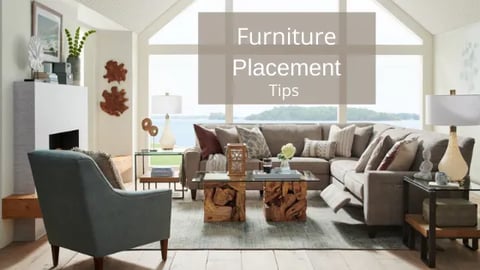
Designing the layout of your living room can feel like solving a puzzle with endless pieces. Between selecting the right furniture, planning around doorways and windows, and ensuring everything flows together visually, it’s no surprise that many people find this part of home design intimidating.
But getting your living room layout right can completely transform the space, making it more inviting, functional, and uniquely yours.
To help guide you through the process, La-Z-Boy Kanata Interior Designer Zeina Badawi shares her expert insights on how to arrange your living room furniture for comfort and style thoughtfully.
Key Takeaways:
- Starting with a clear layout plan is essential to creating a functional and visually balanced living room that suits both your lifestyle and your design preferences.
- The placement and selection of furniture should encourage natural social interaction while also allowing for smooth, unobstructed movement throughout the space.
- Lighting, area rugs, and wall art are more than decorative elements—they play a crucial role in setting the tone and tying the entire room together, both aesthetically and atmospherically.
- Maintaining the right scale and proportion across all furniture and decor items ensures that the room feels harmonious, comfortable, and well-organized, regardless of its size.
- Incorporating a strong focal point helps to visually ground the space, giving the eye a place to rest and providing a central feature around which the rest of the furniture can be arranged.
In This Article…
- Plan Your Living Room Layout
- Pick a Strong Focal Point
- Arrange for Easy Conversation
- Get Scale and Proportion Right
- Plan for Traffic Flow
- Select the Right Size Area Rug
- Add the Proper Lighting to Your Living Room
- Pick Art That Fits the Space
1. Plan Your Living Room Layout
Before you fall in love with a plush sectional or a modern accent chair, take a moment to plan your space.
“Many of us tend to shop for and select the furniture we love without making a plan,” says Zeina. “Then, when all the pieces start to arrive, the task of finding a spot for everything becomes overwhelming.”
Start by asking yourself:
- How will you use this space? Is it a space for movie nights, entertaining guests, or quiet reading?
- How many people will use it regularly?
- Do you want a formal or relaxed mood?
The mood you’re trying to achieve also plays a big role. If you're drawn to elegant, more traditional spaces, a symmetrical layout with matching furniture on either side can create that classic look. For a casual or eclectic vibe, opt for asymmetrical arrangements that feel more relaxed and organic.


2. Pick a Strong Focal Point
A strong focal point is essential in any well-designed room. It provides the visual anchor that pulls the space together and sets the tone for how the rest of your furniture is arranged. If your home has architectural elements like a fireplace, a large picture window, or built-in shelving, use those features to your advantage.
If your space is a blank slate, you can create a focal point with a bold piece of furniture, such as a statement sofa or a beautifully styled console table. Wall treatments like patterned wallpaper or a collection of framed art can also work effectively.
“Use a grouping of your own living room furniture as a focal point,” Zeina explains. “And don’t forget to ground the space with a well-coordinated area rug.”
When arranged correctly, your focal point should draw attention and create a natural flow that invites people into the space. La-Z-Boy has many Best-Selling Sofas and Coffee Tables to help you get started.


3. Arrange for Easy Conversation
A comfortable conversation flow is essential in any well-designed living room. Rather than having guests shout across the space, position your seating so everyone is within a comfortable speaking distance.
“You want to create a cohesive look while making conversation in the room comfortable,” says Zeina. Whether you’re furnishing a small condo or a spacious family room, thoughtful layout choices can make all the difference.
Here are a few easy and effective layout ideas:
- A sofa with two accent chairs facing each other across a coffee table.
- Two chairs around an ottoman for a cozy nook.
- A curved sectional is ideal for large rooms, placed centrally for easy gathering.
La-Z-Boy makes arranging conversation areas simple with flexible options like compact loveseats for tighter spaces or modular sectionals like the Meyer and Collins, which can be configured to fit your home and lifestyle.
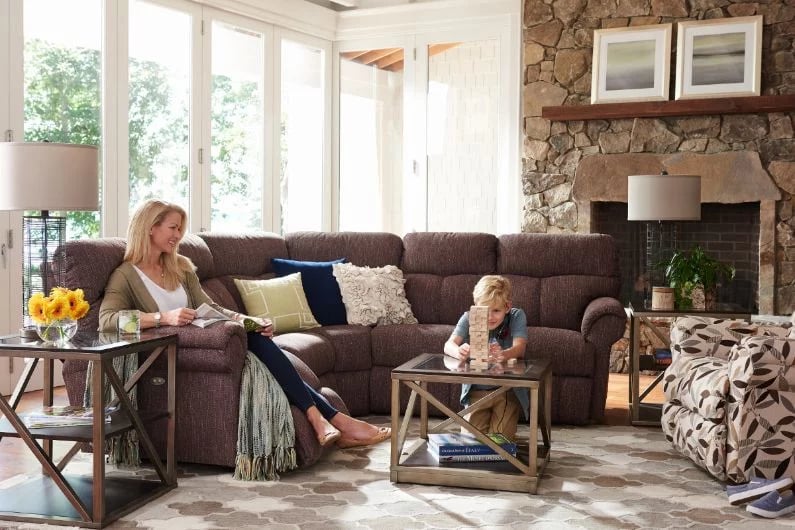
4. Get Scale and Proportion Right
Your furniture should match the scale of your space.
“Balance is essential when arranging furniture in your living room,” says Zeina. “Match the proportion of furniture, tables, and art to the room size.”
A high-ceiling room can handle tall, deep-seated sofas and oversized lighting. In contrast, a smaller living room in a downtown condo may benefit from sleek, low-profile furniture.
Pro Tip: Avoid placing all large furniture on one side of the room — spread weight evenly to create harmony. Leave white space to prevent visual clutter.
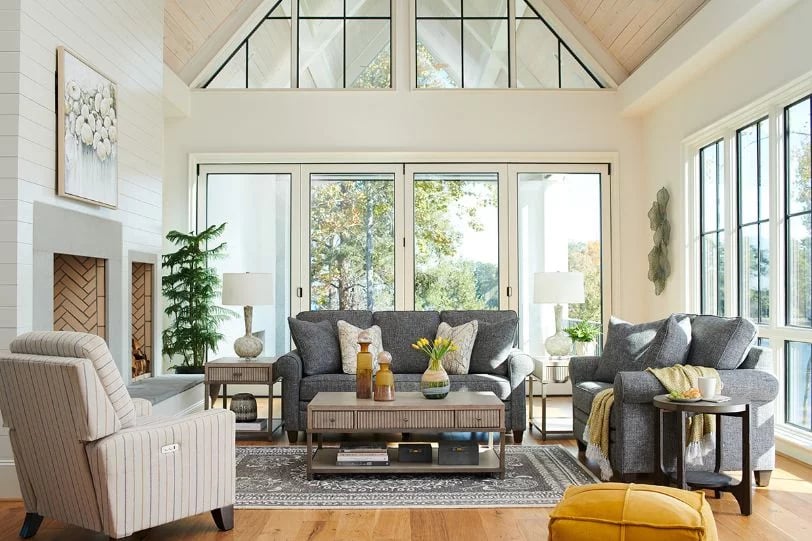
5. Plan for Traffic Flow
Functionality should guide the flow of your living room. Consider how people will walk through the space from one point to another, whether it’s to grab snacks from the kitchen, access a hallway, or open a patio door.
Coffee tables should be placed far enough away from the sofa to allow people to walk comfortably through the area—ideally, 18 to 36 inches. To learn more about Coffee Table Placements, take a look at this article.
Recliners, such as the Pinnacle or Trouper, need room to extend fully. “Remember, you’ll need clearance behind and in front of the chair—at least 6 inches at the back and 20 inches for the footrest,” says Zeina.
If accessibility is a priority, such as for seniors or wheelchair users, be mindful of turning radiuses and furniture height. Sectionals with open ends or ottomans that can be moved easily may be helpful in these cases.
To learn more about La-Z-Boy’s Best-Selling Sectionals, or Best-Selling Ottomans, read these articles.
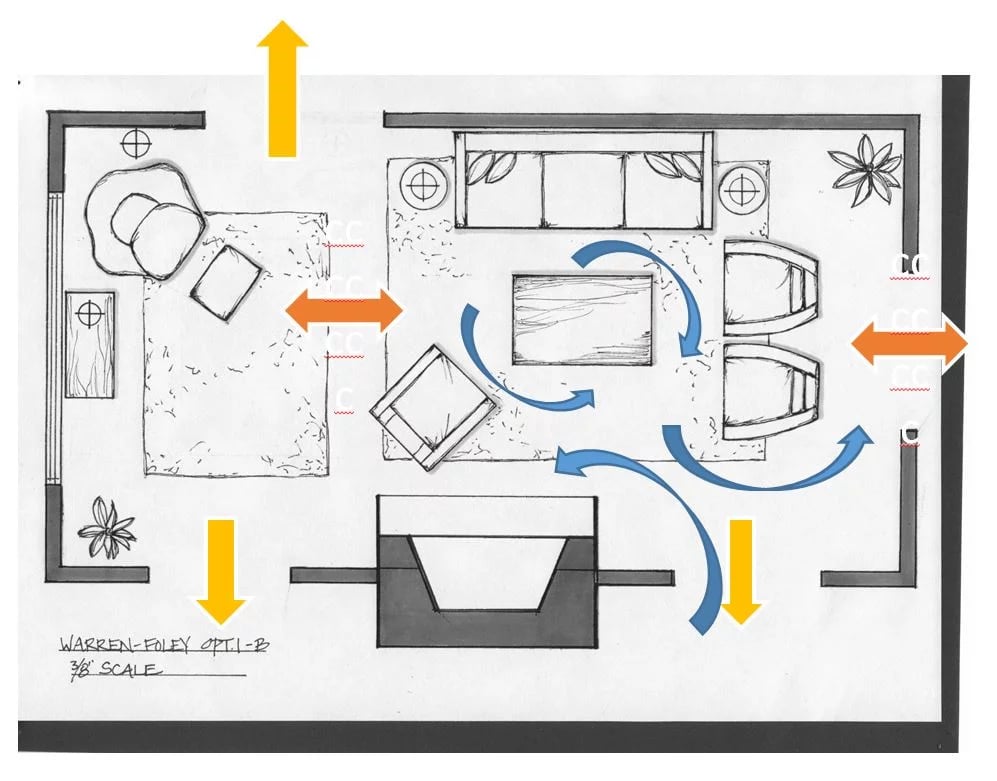
6. Select The Right Size Area Rug
An area rug does more than add colour or texture—it defines the boundaries of your living room and ties the entire space together. The key to selecting the right rug size is to match it to your furniture layout.
For a rectangular room, avoid using square rugs. Instead, go with a rug that follows the room’s dimensions and place the longer edge parallel to the longest wall. The rug should be large enough that at least the front legs of your sofa and chairs are resting on it. When all legs are on the rug, it creates a unified, anchored seating area.
Smaller rugs with furniture completely off the edges can make a space look disconnected or cramped. “The right rug creates the illusion of a larger room while visually connecting all your furniture,” explains Zeina.
To learn more about how to select the Perfect Area Rug for Your Home, take a look at this article.

7. Add the Proper Lighting to Your Living Room
Overhead lighting alone can make your living room feel stark or clinical. “Pot lights offer lots of light, but they’re not ideal for ambiance,” says Zeina. “They can be unflattering and even contribute to eye fatigue over time.”
Instead, layer your lighting with multiple sources—ambient, task, and accent lighting. Table lamps are a must-have for creating warm, inviting pockets of light. Position them near reading chairs, on side tables, or next to the sofa to make your space feel cozy and well-thought-out.
For inspiration, explore our article on How to Add Light to Your Living Room with Table Lamps.
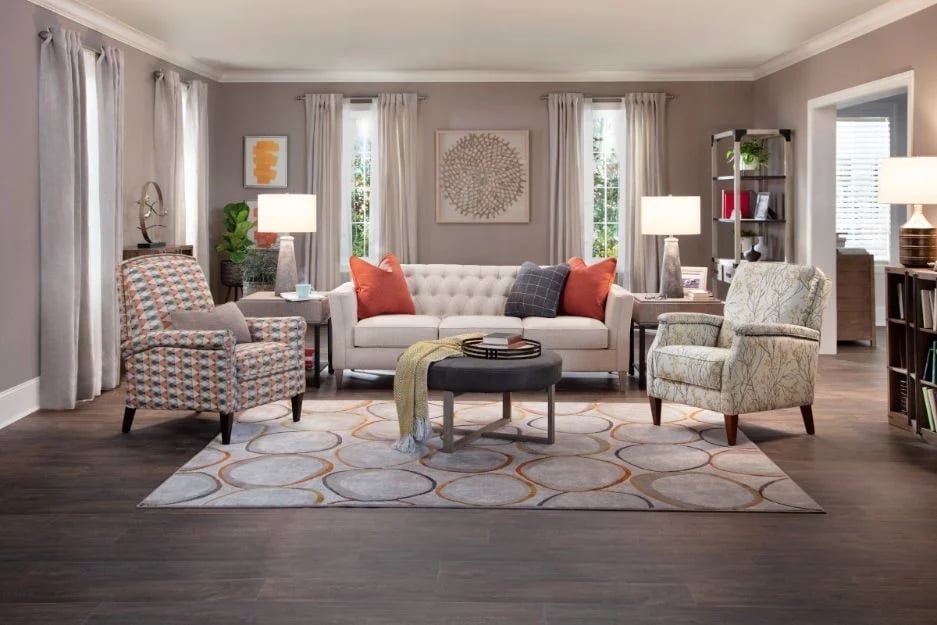
8. Pick Art That Fits the Space
Artwork plays a crucial role in tying together your space. Yet, one of the most common mistakes people make is hanging pieces too high or choosing art that’s too small for the wall.
“A small piece works best when ‘contained’—like between a door and window,” says Zeina. “Larger walls demand either one oversized piece or a well-curated gallery wall.”
Hang art so that its center is about 58 inches from the floor; this is considered average eye level and ensures the piece is easy to view. If the art is going above a sofa, aim to place it about 4 to 6 inches above the backrest for balance. Choose artwork that speaks to your style, complements your colour scheme, and fits the scale of the furniture around it.
For more guidance, check out our article How to Decorate Your Home in Layers.
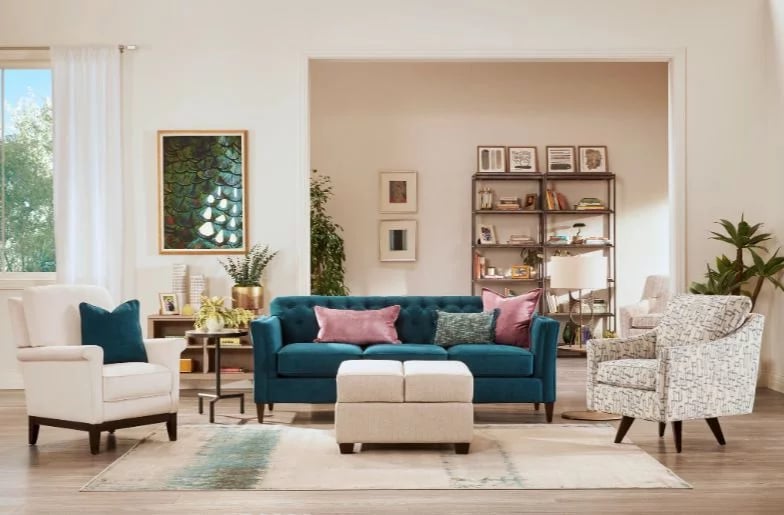
What's Next?
Now that you know how to arrange your furniture properly, it is up to you to decide how you will decorate your space.
While learning about our home decor selections, you can visit one of our La-Z Boy Ottawa, Gatineau & Kingston stores to see our home decor items in person. You can also schedule a visit online before coming in.
Our design consultants are always eager to lend a helping hand. Take advantage of our complimentary interior design services to see how our furniture and decor could fit in your home.
To learn more about our La-Z-Boy decor selection, take a look at this comprehensive Decor Buyer’s Guide.
(1).jpg?width=150&height=150&name=9C8A3062-Enhanced-NR%20(1)(1).jpg)
Nicholas Carchidi
Content Writer at StyleMeetsComfort.ca
Nick has been the lead content writer for La-Z-Boy Ottawa, Gatineau and Kingston since 2022, specializing in the furniture industry. He collaborates with experts in his field, ensuring that each piece on the La-Z-Boy Learning Centre is accurate and valuable. He provides readers with expert knowledge on all things furniture. If you'd like to learn more about Nick, you can check out his LinkedIn page here.
Product Info Request
Please provide us with your name and email and we'll get back to you as soon as possible regarding this item.
